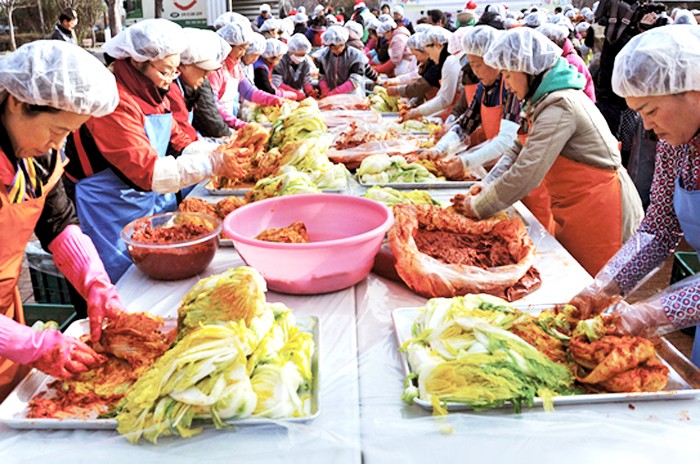(VOVworld) – Kimjang is the most typical example of food culture in the Republic of Korea. In Korean, Kimjang means making large quantities of Kimchi. In 2013, UNESCO recognized Kimjang as an intangible cultural heritage of humanity, which promotes solidarity among Korean people. In today’s Culture Rendezvous, we will introduce to you Kimjang, the special Korean culture of making and sharing Kimchi.
Kimjang reminds people of harmony with nature while learning about the harmony of the ingredients resulting in fermented food, Kimchi. Since making and sharing Kimchi is a co-work, it needs cooperation and teamwork, which can be an opportunity to enhance solidarity in families or communities. Jeong Hyun Ryu, a Korean English teacher living in Hanoi said : Kimjang often happens in a family, but it also happens among all the community members in a town. Since Kimjang is basically an event in which a lot of people should gather, people can communicate each other and they also can socialize while making Kimchi. Moreover, they can share each other the different ways of making Kimchi as well as the Kimchi made by other members of the community. So, we can say Kimjang is one of the important ways of promoting solidarity and providing a sense of belonging among the community members in Korea.

Kimjang, one of Korea's food cultures, was listed as an intangible culture heritage by the UNESCO in 2013. Photo: visitkorea.or.kr
|
There is no specific date for Kimjang, but from the late fall to winter is the best season. Prior to the making, there are usually a lot of ingredients to prepare. The preparation follows a yearly cycle. In spring, households prepare shrimp, anchovies and other seafoods for salting and fermenting. In summer, they buy salt for the brine. In late summer, red chili peppers are dried and ground into powder. In the Kimjang season, communities collectively make and share large quantities of kimchi to ensure that every household has enough to sustain it through the long, harsh winter. Ryu explained the steps to making Kimchi : In traditional way, we salt Chinese cabbage first, and mix chili pepper powder, chopped garlic, fermented seafood and other ingredients needed to combine with the salted Chinese cabbage. When all the ingredients are mixed, we put Kimchi in the Kimchi jars and bury them in the ground in order to prevent freezing, and to keep the adequate taste for a long time. So Kimchi is fermented in the Kimchi jars. All the procedures making Kimchi is quite the same nowadays. However, as technology advanced, Korean people don’t usually use Kimchi jars but normally use Kimchi fridge which is special refrigerator for making Kimchi.

When all the ingredients are mixed, Kimchi is put in the Kimchi jars and burried in the ground. (Photo: Cultural Heritage Administration)
|
When Kimjang happens in a family, usually the eldest female relative tries to gather all the female family members, including the daughter-in-law and others who can join the event. In order to have them all gather and make Kimjang together, the members choose an available date when most of them can participate. Then people usually gather in the house of someone’s eldest brother. In the past, when the women in a town shared strong social bonds, they could suggest doing Kimjang together because it was an annual event, and making a large quantity of Kimchi for the whole year is so laborious that working together is a better idea. So they can work together in a house whose front yard is big enough to hold many people and to store a large amount of ingredients. Kimjang was recognized as an intangible cultural heritage of Korea in 2013. Ryu said :Kimjang is the cultural event that is passed down through generation to generation. Since Kimjang is basically making Kimchi together, and sharing it each other, Kimjang unites people and make them connected. Besides, the way of making Kimchi is different from region to region, so Kimjang encourages each community to communicate and share their traditional ways of making Kimchi which have regional characteristics and creativity.
As more and more families become nuclear families and there is less of a social bond among members of a town, so fewer Koreans share Kimchi. Also, these days, people prefer buying it because Kimjang is a laborious work. On the other hand, traditional head families or people with large families still do Kimjang, and there are also families who prefer doing it themselves because they prefer the flavor of their traditional recipe. Kimjang, which means making and sharing Kimchi together, is an important part of Korea’s identity. Kimjang is considered crucial to the extent of the Korean language Hangeul or the Korean flag TaegeukGi.